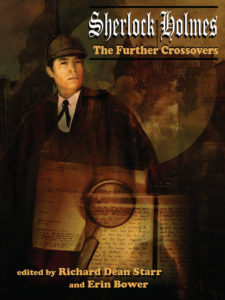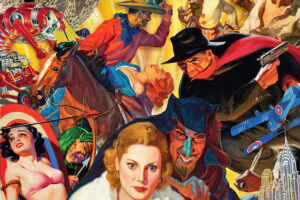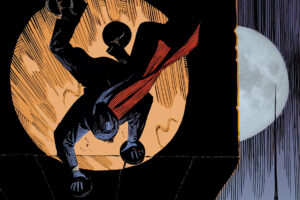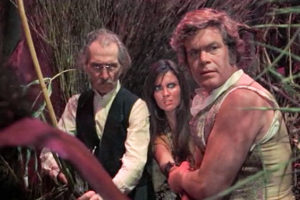 Some time back I reviewed Moonstone Books‘ collection of Sherlock Holmes stories: Sherlock Holmes: The Crossover Casebook. As the title implies, all the stories have Holmes meeting or teaming up with various well-known characters, both real and fictional.
Some time back I reviewed Moonstone Books‘ collection of Sherlock Holmes stories: Sherlock Holmes: The Crossover Casebook. As the title implies, all the stories have Holmes meeting or teaming up with various well-known characters, both real and fictional.
Moonstone has since put out a second one, The Further Crossovers of Sherlock Holmes, this time edited by Richard Dean Starr and E.R. Bower, with nearly a dozen new crossovers. These stories range from before Holmes had become a detective to when he had retired.
We get a great introduction to kick things off, and this time around we get the following authors:
Patricia Barletta “The Adventure of the Flying Carpet” has Holmes and Watson work on finding a stolen prayer rug that seems to have flown away. The carpet had been obtained by Gertrude Bell, a real person who was a renowned adventurer, archeologist, and spy for England in the Middle East. Jules Verne also appears but doesn’t have a big role to play. Hopefully readers will pick up on another character who appears.
David Stuart Davies: He gives us an interesting Holmes story in “Secret of the Dead.” DSD has done many Holmes novels and stories, and this one goes back to Holmes’ youth where he met the retired Sergeant Cuff from Wilkie Collin‘s The Moonstone, and learns the art of detection. They solve a pair of accidents that may be a crime together.
Nancy Holder: “A Second Study in Emerald” has Holmes and Watson going after a criminal who has apparently hidden out in a “Wild West” show, leading to a tale of love, betrayal, and double murder. Along the way they team up with Lady Molly of Scotland Yard, an early detective created by Baroness Orczy, who created The Scarlet Pimpernel.
Bradley H. Sinor: “The Adventure of the Man in the White Suit” has Holmes and Watson meeting Mark Twain, and getting involved in a matter of someone inpersonating Nicola Tesla and engaging in espionage.
Julie Barret: “The Lady Detective” has another team up with a fictional female detective, this one Loveday Brooke by Catherine Louisa Pirkis. She was published around the same time as Holmes. In another case done for the British government, they team up to obtain some sensitive papers.
David Gerrold: “The Case of the Green Carnation” has Oscar Wilde asking Holmes and Watson to help deal with blackmail of a close friend. If you know something about Wilde’s real life, you’ll quickly get the point.
Jean Rabe: “Toole’s Folly” has Holmes alone looking for someone attacking actors, in particular ones who are female impersonators. Included in the case are a couple of real actors, Malcolm Scott and Matilda Alice Powles.
Greg Gick: “Return of the Winchester Man” has Holmes meeting up with Craig Kennedy, a popular science detective created by Arthur B. Reeve who appeared in both slick and pulp magazines, and collected in some 20 or so collections. I’ve not read him, because I just don’t know where to begin. Here he is called to Chicago to help solve a murder by a returned hit man, where he mets up with Holmes in disguise working on another case. They team up to solve both cases. (One problem is the author confuses rifles and shotguns in this story.)
Matthew V. Clemens: “The Adventure of the French Connection” doesn’t have Popeye Doyle, but does have two real people: Alexandre Lacassagne, French physician and criminologist who founded a school of criminology, and his then-assistant Edmond Locard who would later be called the “Sherlock Holmes of France.” Here Holmes and Watson help the two in tracking down and stopping a copycat serial killer, with the help of another character.
Martin Gately: “The Adventures of the Snaresbrook Assizes” has Joséph Rouletabille. the French investigative journalist and occasional spy. I’ve posted on him before and encourage people to check him out. Here he is working in association with the British looking for German spies when he goes missing and Mycroft brings in Holmes. This story is a variant of a story using Rouletabille and Harry Dickson that appeared in Tales of the Shadowmen.
Bill Crider: “The Case of the Anarchist’s Bomb” has Watson by himself, during the period that Holmes was thought dead. Here he is brought in by Mycroft to figure out the death of an anarchist. He is helped by a another individual who may be more than he appears.
Again, it’s another great collection. My only complaint is I would have liked to have seen a set of brief bios on the authors. That is something I’ve come to expect in anthologies. I would like to see a third collection as well. Yet another great collection of new Holmes stories.




I love Estlemans. Sherlock Holmes vs Dracula: athe Adventure of the Sanguinary Count!